Developing HR Skills, Performance, and Organisational Growth
VerifiedAdded on 2020/06/06
|18
|4904
|159
Report
AI Summary
This report delves into the critical aspects of human resource management, focusing on the knowledge, skills, and behaviors essential for HR professionals. It examines the importance of continuous learning and explores personal skill audits, using Jane Cambridge as a case study, to create a professional development plan. The report differentiates between organizational and individual learning, emphasizing their interconnectedness. Furthermore, it analyzes the contribution of high-performance working towards competitive advantage and employee engagement, and details various approaches to performance management. The report underscores the significance of these elements in fostering individual, team, and organizational growth, ultimately leading to enhanced business success. The report also highlights the importance of negotiation skills, communication, and multitasking abilities for HR professionals.

DEVELOPING
INDIVIDUAL, TEAMS AND
ORGANISATIONS
THIS ASSIGNMENT
HAVE NOTHING TO DO
WITH TESCO COMPANY?
YOU DONT NEED TO
APPLY TO TESCO
INDIVIDUAL, TEAMS AND
ORGANISATIONS
THIS ASSIGNMENT
HAVE NOTHING TO DO
WITH TESCO COMPANY?
YOU DONT NEED TO
APPLY TO TESCO
Paraphrase This Document
Need a fresh take? Get an instant paraphrase of this document with our AI Paraphraser
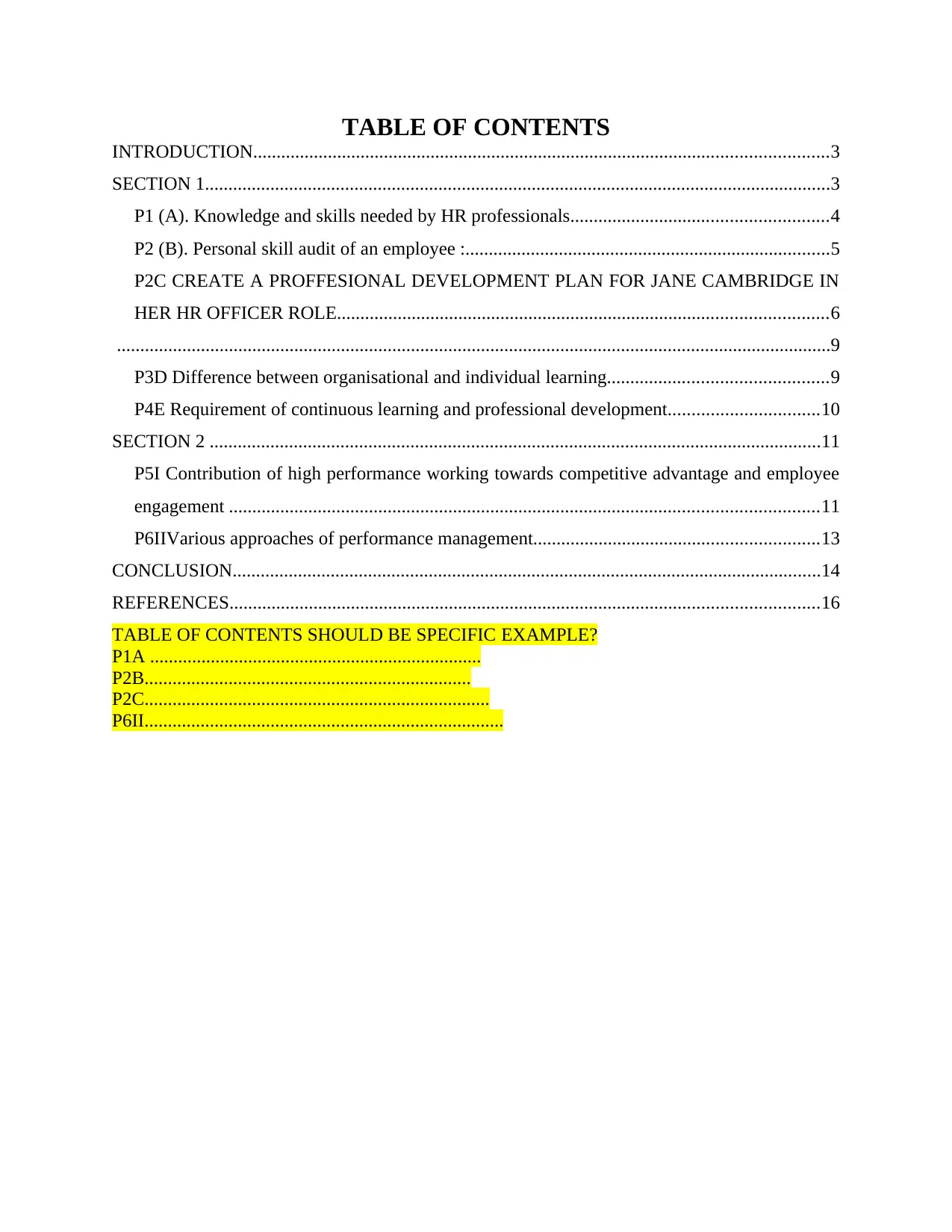
TABLE OF CONTENTS
INTRODUCTION...........................................................................................................................3
SECTION 1......................................................................................................................................3
P1 (A). Knowledge and skills needed by HR professionals.......................................................4
P2 (B). Personal skill audit of an employee :..............................................................................5
P2C CREATE A PROFFESIONAL DEVELOPMENT PLAN FOR JANE CAMBRIDGE IN
HER HR OFFICER ROLE.........................................................................................................6
.........................................................................................................................................................9
P3D Difference between organisational and individual learning...............................................9
P4E Requirement of continuous learning and professional development................................10
SECTION 2 ...................................................................................................................................11
P5I Contribution of high performance working towards competitive advantage and employee
engagement ..............................................................................................................................11
P6IIVarious approaches of performance management.............................................................13
CONCLUSION..............................................................................................................................14
REFERENCES..............................................................................................................................16
TABLE OF CONTENTS SHOULD BE SPECIFIC EXAMPLE?
P1A .......................................................................
P2B......................................................................
P2C..........................................................................
P6II.............................................................................
INTRODUCTION...........................................................................................................................3
SECTION 1......................................................................................................................................3
P1 (A). Knowledge and skills needed by HR professionals.......................................................4
P2 (B). Personal skill audit of an employee :..............................................................................5
P2C CREATE A PROFFESIONAL DEVELOPMENT PLAN FOR JANE CAMBRIDGE IN
HER HR OFFICER ROLE.........................................................................................................6
.........................................................................................................................................................9
P3D Difference between organisational and individual learning...............................................9
P4E Requirement of continuous learning and professional development................................10
SECTION 2 ...................................................................................................................................11
P5I Contribution of high performance working towards competitive advantage and employee
engagement ..............................................................................................................................11
P6IIVarious approaches of performance management.............................................................13
CONCLUSION..............................................................................................................................14
REFERENCES..............................................................................................................................16
TABLE OF CONTENTS SHOULD BE SPECIFIC EXAMPLE?
P1A .......................................................................
P2B......................................................................
P2C..........................................................................
P6II.............................................................................

⊘ This is a preview!⊘
Do you want full access?
Subscribe today to unlock all pages.

Trusted by 1+ million students worldwide
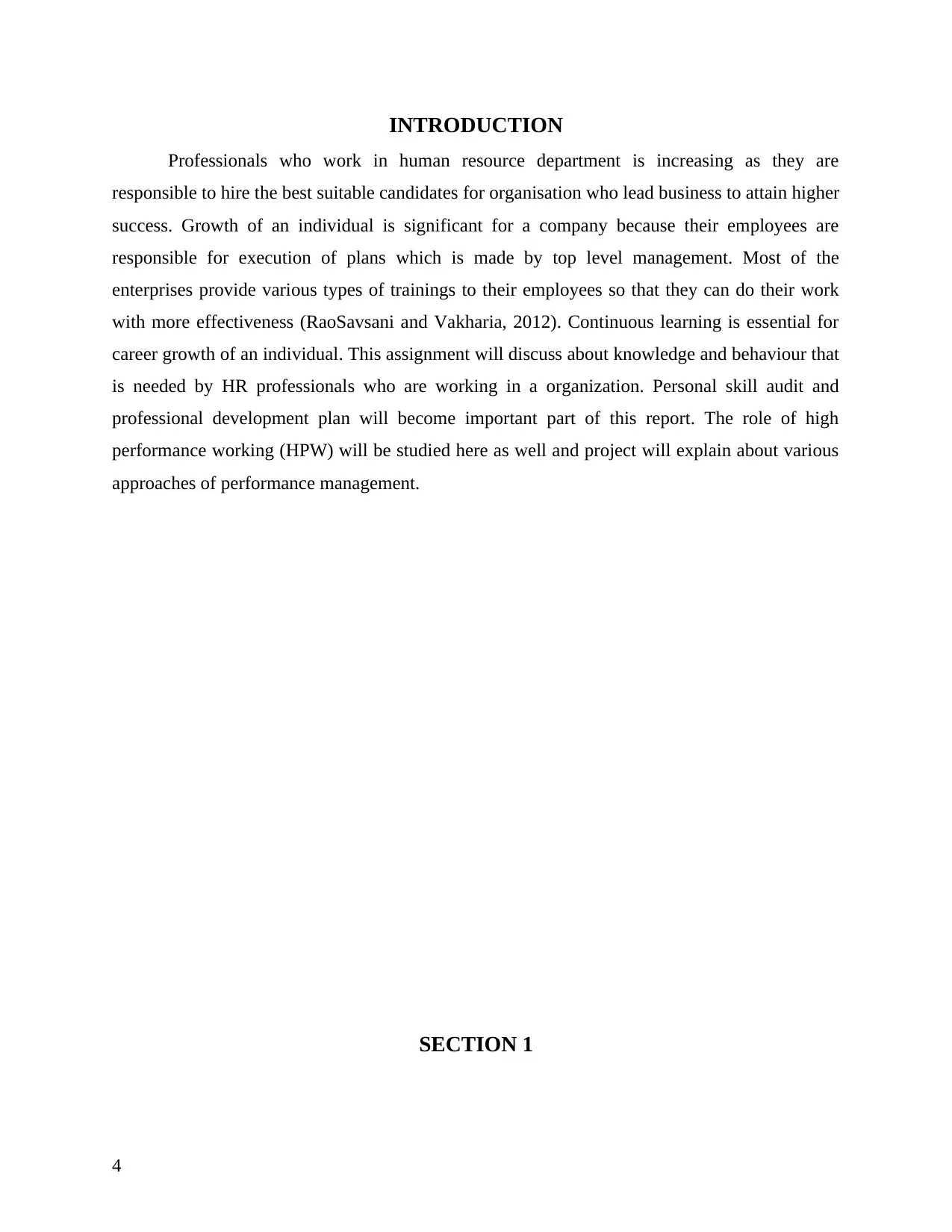
INTRODUCTION
Professionals who work in human resource department is increasing as they are
responsible to hire the best suitable candidates for organisation who lead business to attain higher
success. Growth of an individual is significant for a company because their employees are
responsible for execution of plans which is made by top level management. Most of the
enterprises provide various types of trainings to their employees so that they can do their work
with more effectiveness (RaoSavsani and Vakharia, 2012). Continuous learning is essential for
career growth of an individual. This assignment will discuss about knowledge and behaviour that
is needed by HR professionals who are working in a organization. Personal skill audit and
professional development plan will become important part of this report. The role of high
performance working (HPW) will be studied here as well and project will explain about various
approaches of performance management.
SECTION 1
4
Professionals who work in human resource department is increasing as they are
responsible to hire the best suitable candidates for organisation who lead business to attain higher
success. Growth of an individual is significant for a company because their employees are
responsible for execution of plans which is made by top level management. Most of the
enterprises provide various types of trainings to their employees so that they can do their work
with more effectiveness (RaoSavsani and Vakharia, 2012). Continuous learning is essential for
career growth of an individual. This assignment will discuss about knowledge and behaviour that
is needed by HR professionals who are working in a organization. Personal skill audit and
professional development plan will become important part of this report. The role of high
performance working (HPW) will be studied here as well and project will explain about various
approaches of performance management.
SECTION 1
4
Paraphrase This Document
Need a fresh take? Get an instant paraphrase of this document with our AI Paraphraser
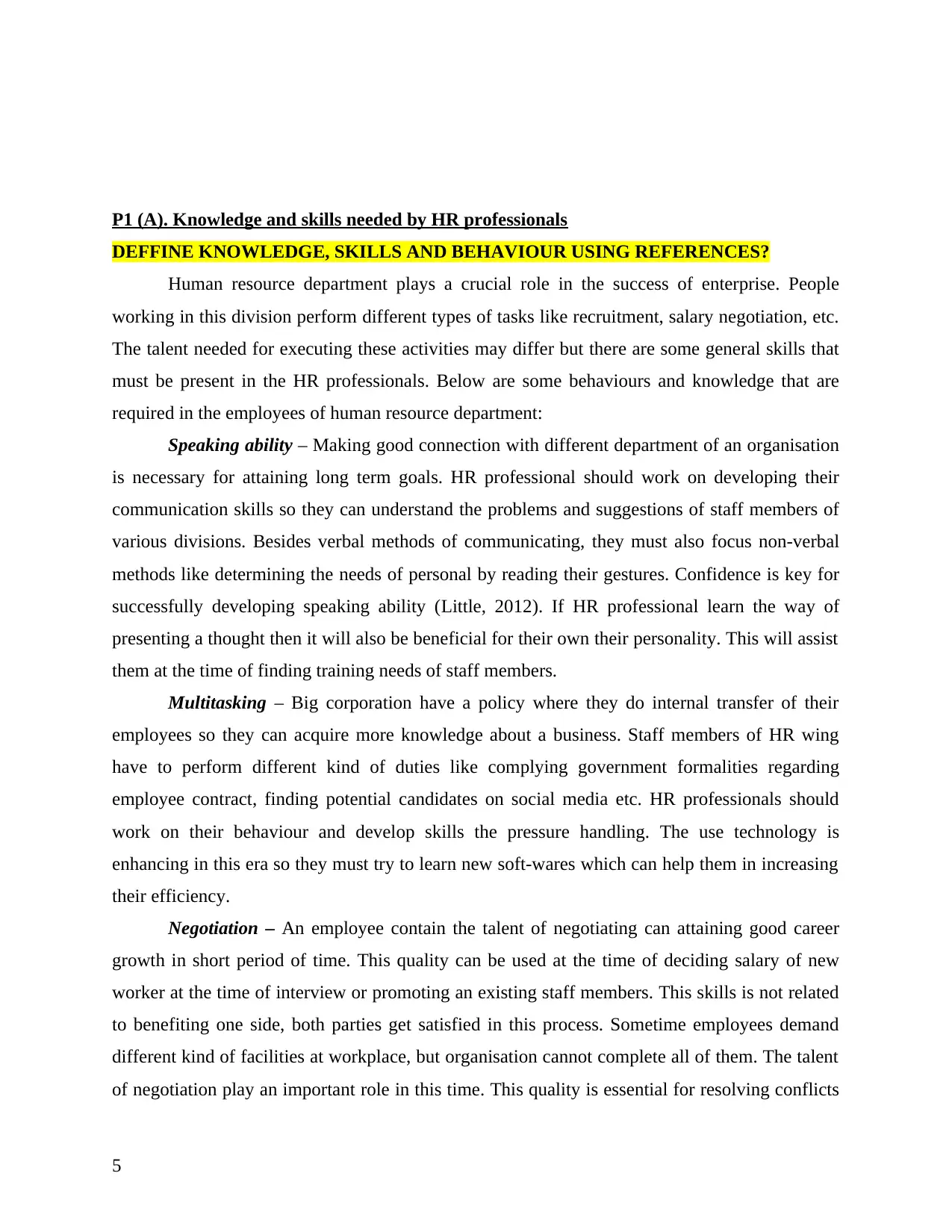
P1 (A). Knowledge and skills needed by HR professionals
DEFFINE KNOWLEDGE, SKILLS AND BEHAVIOUR USING REFERENCES?
Human resource department plays a crucial role in the success of enterprise. People
working in this division perform different types of tasks like recruitment, salary negotiation, etc.
The talent needed for executing these activities may differ but there are some general skills that
must be present in the HR professionals. Below are some behaviours and knowledge that are
required in the employees of human resource department:
Speaking ability – Making good connection with different department of an organisation
is necessary for attaining long term goals. HR professional should work on developing their
communication skills so they can understand the problems and suggestions of staff members of
various divisions. Besides verbal methods of communicating, they must also focus non-verbal
methods like determining the needs of personal by reading their gestures. Confidence is key for
successfully developing speaking ability (Little, 2012). If HR professional learn the way of
presenting a thought then it will also be beneficial for their own their personality. This will assist
them at the time of finding training needs of staff members.
Multitasking – Big corporation have a policy where they do internal transfer of their
employees so they can acquire more knowledge about a business. Staff members of HR wing
have to perform different kind of duties like complying government formalities regarding
employee contract, finding potential candidates on social media etc. HR professionals should
work on their behaviour and develop skills the pressure handling. The use technology is
enhancing in this era so they must try to learn new soft-wares which can help them in increasing
their efficiency.
Negotiation – An employee contain the talent of negotiating can attaining good career
growth in short period of time. This quality can be used at the time of deciding salary of new
worker at the time of interview or promoting an existing staff members. This skills is not related
to benefiting one side, both parties get satisfied in this process. Sometime employees demand
different kind of facilities at workplace, but organisation cannot complete all of them. The talent
of negotiation play an important role in this time. This quality is essential for resolving conflicts
5
DEFFINE KNOWLEDGE, SKILLS AND BEHAVIOUR USING REFERENCES?
Human resource department plays a crucial role in the success of enterprise. People
working in this division perform different types of tasks like recruitment, salary negotiation, etc.
The talent needed for executing these activities may differ but there are some general skills that
must be present in the HR professionals. Below are some behaviours and knowledge that are
required in the employees of human resource department:
Speaking ability – Making good connection with different department of an organisation
is necessary for attaining long term goals. HR professional should work on developing their
communication skills so they can understand the problems and suggestions of staff members of
various divisions. Besides verbal methods of communicating, they must also focus non-verbal
methods like determining the needs of personal by reading their gestures. Confidence is key for
successfully developing speaking ability (Little, 2012). If HR professional learn the way of
presenting a thought then it will also be beneficial for their own their personality. This will assist
them at the time of finding training needs of staff members.
Multitasking – Big corporation have a policy where they do internal transfer of their
employees so they can acquire more knowledge about a business. Staff members of HR wing
have to perform different kind of duties like complying government formalities regarding
employee contract, finding potential candidates on social media etc. HR professionals should
work on their behaviour and develop skills the pressure handling. The use technology is
enhancing in this era so they must try to learn new soft-wares which can help them in increasing
their efficiency.
Negotiation – An employee contain the talent of negotiating can attaining good career
growth in short period of time. This quality can be used at the time of deciding salary of new
worker at the time of interview or promoting an existing staff members. This skills is not related
to benefiting one side, both parties get satisfied in this process. Sometime employees demand
different kind of facilities at workplace, but organisation cannot complete all of them. The talent
of negotiation play an important role in this time. This quality is essential for resolving conflicts
5
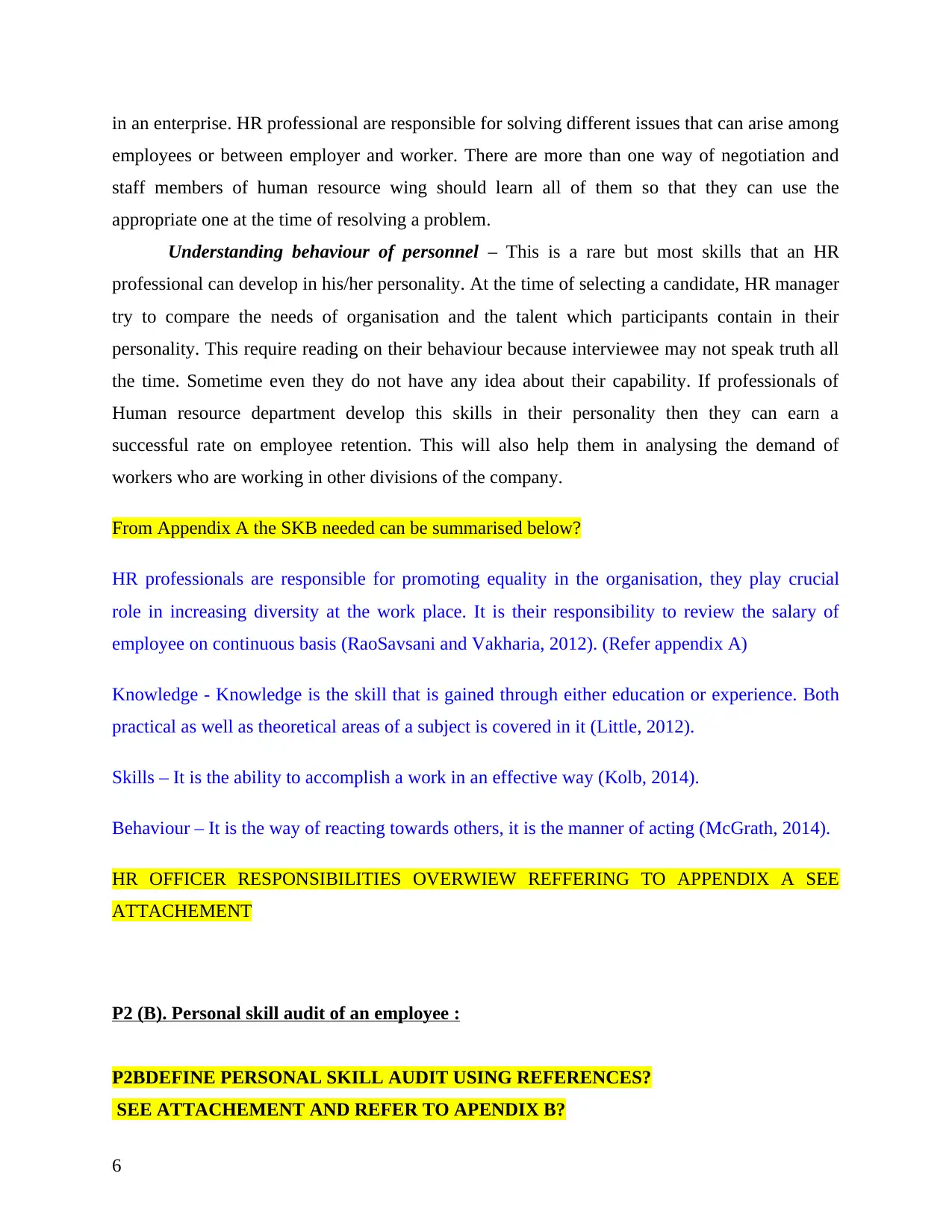
in an enterprise. HR professional are responsible for solving different issues that can arise among
employees or between employer and worker. There are more than one way of negotiation and
staff members of human resource wing should learn all of them so that they can use the
appropriate one at the time of resolving a problem.
Understanding behaviour of personnel – This is a rare but most skills that an HR
professional can develop in his/her personality. At the time of selecting a candidate, HR manager
try to compare the needs of organisation and the talent which participants contain in their
personality. This require reading on their behaviour because interviewee may not speak truth all
the time. Sometime even they do not have any idea about their capability. If professionals of
Human resource department develop this skills in their personality then they can earn a
successful rate on employee retention. This will also help them in analysing the demand of
workers who are working in other divisions of the company.
From Appendix A the SKB needed can be summarised below?
HR professionals are responsible for promoting equality in the organisation, they play crucial
role in increasing diversity at the work place. It is their responsibility to review the salary of
employee on continuous basis (RaoSavsani and Vakharia, 2012). (Refer appendix A)
Knowledge - Knowledge is the skill that is gained through either education or experience. Both
practical as well as theoretical areas of a subject is covered in it (Little, 2012).
Skills – It is the ability to accomplish a work in an effective way (Kolb, 2014).
Behaviour – It is the way of reacting towards others, it is the manner of acting (McGrath, 2014).
HR OFFICER RESPONSIBILITIES OVERWIEW REFFERING TO APPENDIX A SEE
ATTACHEMENT
P2 (B). Personal skill audit of an employee :
P2BDEFINE PERSONAL SKILL AUDIT USING REFERENCES?
SEE ATTACHEMENT AND REFER TO APENDIX B?
6
employees or between employer and worker. There are more than one way of negotiation and
staff members of human resource wing should learn all of them so that they can use the
appropriate one at the time of resolving a problem.
Understanding behaviour of personnel – This is a rare but most skills that an HR
professional can develop in his/her personality. At the time of selecting a candidate, HR manager
try to compare the needs of organisation and the talent which participants contain in their
personality. This require reading on their behaviour because interviewee may not speak truth all
the time. Sometime even they do not have any idea about their capability. If professionals of
Human resource department develop this skills in their personality then they can earn a
successful rate on employee retention. This will also help them in analysing the demand of
workers who are working in other divisions of the company.
From Appendix A the SKB needed can be summarised below?
HR professionals are responsible for promoting equality in the organisation, they play crucial
role in increasing diversity at the work place. It is their responsibility to review the salary of
employee on continuous basis (RaoSavsani and Vakharia, 2012). (Refer appendix A)
Knowledge - Knowledge is the skill that is gained through either education or experience. Both
practical as well as theoretical areas of a subject is covered in it (Little, 2012).
Skills – It is the ability to accomplish a work in an effective way (Kolb, 2014).
Behaviour – It is the way of reacting towards others, it is the manner of acting (McGrath, 2014).
HR OFFICER RESPONSIBILITIES OVERWIEW REFFERING TO APPENDIX A SEE
ATTACHEMENT
P2 (B). Personal skill audit of an employee :
P2BDEFINE PERSONAL SKILL AUDIT USING REFERENCES?
SEE ATTACHEMENT AND REFER TO APENDIX B?
6
⊘ This is a preview!⊘
Do you want full access?
Subscribe today to unlock all pages.

Trusted by 1+ million students worldwide

Jane Cambridge is an HR professional. She had some skills which helped her in getting a
spot in human resource wing of the organisation. But there are still many qualities which she
need to develop in her personality. Growth of employee is directly connected toP the success of
an enterprise. Below personal skill audit of Jane Cambridge:
Strengths – There are many areas in which Jane has done remarkable work in last couple
of years. She has sound knowledge about the government policies which saves company from
committing any legal mistake. There are many HR professional who are not aware about
organisational culture so at the time of orientation session they fail to make communicate rules
that is present in the enterprise. She has fine communication skills, this can be considered as the
prime reason that most of the employees of different divisions contract her in case they have any
issue.
Weaknesses – HR professionals must possess good negotiation skills, Jane is below
average in this field. This lacuna can become a big hurdle in her career growth and she may have
face various types of difficulties if big corporation transfer them to recruitment wing. Her
knowledge regarding latest technology is below par, this may cost her lots of opportunities in
upcoming time.
Jane can use internet in effective manner but do cannot work of practicals data and her
knowledge about HR soft-wares is weak (Little, 2012). She has fine writing skills but her she can
improve some skills like how to take interview and advising on HR issues etc. She can do good
negotiation but it should be written manner. (Refer appendix B)
P2C CREATE A PROFFESIONAL DEVELOPMENT PLAN FOR JANE CAMBRIDGE IN
HER HR OFFICER ROLE
DEFINE DEVELOPMENT PLAN USING REFERENCES?
WHAT IS THE TABLE BELOW?
PDP is the procedure of creating a plan for increasing values and awareness in a person. Some
goals are set for an individual so he/she can attain them and assure self improvement.
Personal development plan
SR. No LEARNIN
G
OBJECTIV
CURRENT
PROFICE
NCY
TARGET
PROFICE
NCY
DEVELOP
MENT
OPPORTU
CRIRERIA
FOR
JUDGING
TIME
SCALE
7
spot in human resource wing of the organisation. But there are still many qualities which she
need to develop in her personality. Growth of employee is directly connected toP the success of
an enterprise. Below personal skill audit of Jane Cambridge:
Strengths – There are many areas in which Jane has done remarkable work in last couple
of years. She has sound knowledge about the government policies which saves company from
committing any legal mistake. There are many HR professional who are not aware about
organisational culture so at the time of orientation session they fail to make communicate rules
that is present in the enterprise. She has fine communication skills, this can be considered as the
prime reason that most of the employees of different divisions contract her in case they have any
issue.
Weaknesses – HR professionals must possess good negotiation skills, Jane is below
average in this field. This lacuna can become a big hurdle in her career growth and she may have
face various types of difficulties if big corporation transfer them to recruitment wing. Her
knowledge regarding latest technology is below par, this may cost her lots of opportunities in
upcoming time.
Jane can use internet in effective manner but do cannot work of practicals data and her
knowledge about HR soft-wares is weak (Little, 2012). She has fine writing skills but her she can
improve some skills like how to take interview and advising on HR issues etc. She can do good
negotiation but it should be written manner. (Refer appendix B)
P2C CREATE A PROFFESIONAL DEVELOPMENT PLAN FOR JANE CAMBRIDGE IN
HER HR OFFICER ROLE
DEFINE DEVELOPMENT PLAN USING REFERENCES?
WHAT IS THE TABLE BELOW?
PDP is the procedure of creating a plan for increasing values and awareness in a person. Some
goals are set for an individual so he/she can attain them and assure self improvement.
Personal development plan
SR. No LEARNIN
G
OBJECTIV
CURRENT
PROFICE
NCY
TARGET
PROFICE
NCY
DEVELOP
MENT
OPPORTU
CRIRERIA
FOR
JUDGING
TIME
SCALE
7
Paraphrase This Document
Need a fresh take? Get an instant paraphrase of this document with our AI Paraphraser
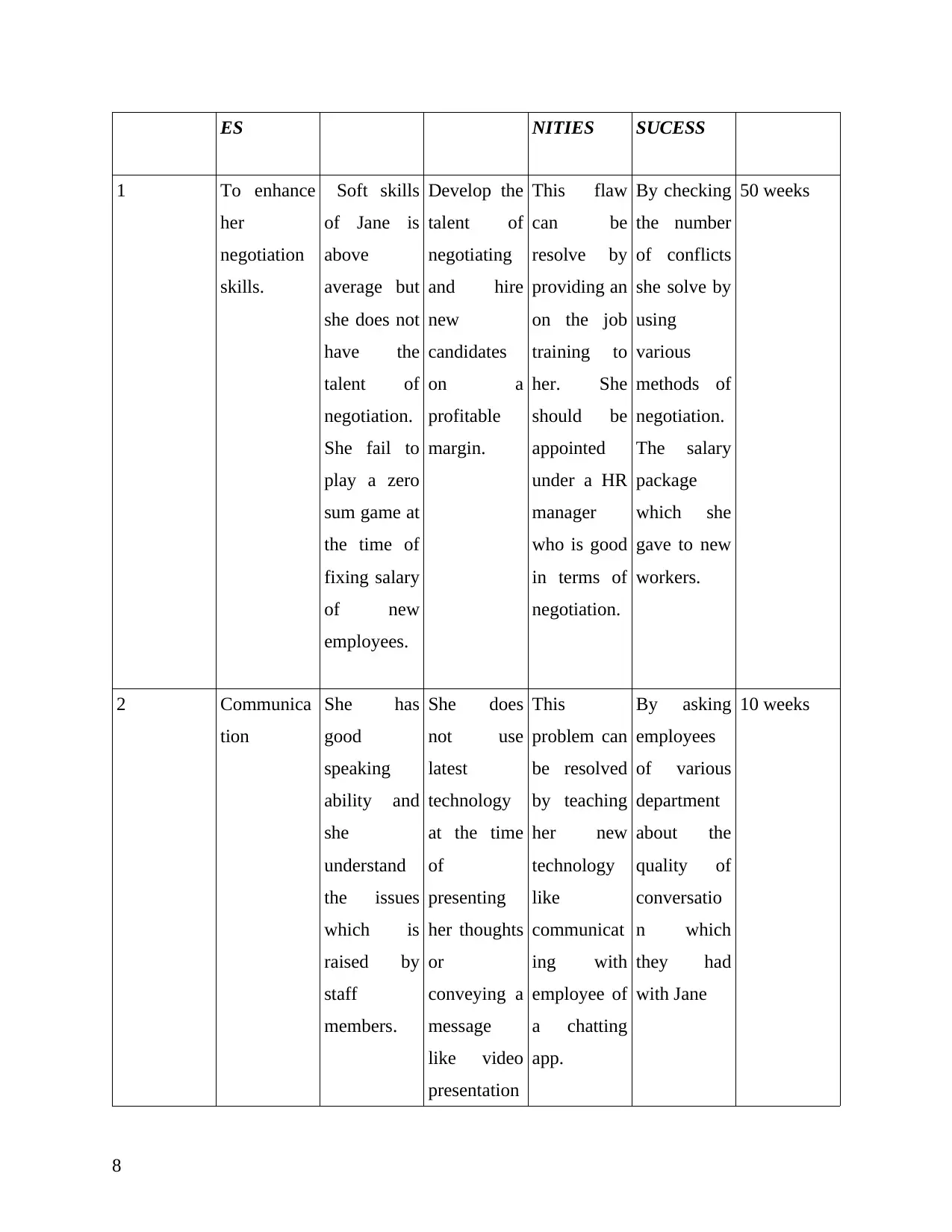
ES NITIES SUCESS
1 To enhance
her
negotiation
skills.
Soft skills
of Jane is
above
average but
she does not
have the
talent of
negotiation.
She fail to
play a zero
sum game at
the time of
fixing salary
of new
employees.
Develop the
talent of
negotiating
and hire
new
candidates
on a
profitable
margin.
This flaw
can be
resolve by
providing an
on the job
training to
her. She
should be
appointed
under a HR
manager
who is good
in terms of
negotiation.
By checking
the number
of conflicts
she solve by
using
various
methods of
negotiation.
The salary
package
which she
gave to new
workers.
50 weeks
2 Communica
tion
She has
good
speaking
ability and
she
understand
the issues
which is
raised by
staff
members.
She does
not use
latest
technology
at the time
of
presenting
her thoughts
or
conveying a
message
like video
presentation
This
problem can
be resolved
by teaching
her new
technology
like
communicat
ing with
employee of
a chatting
app.
By asking
employees
of various
department
about the
quality of
conversatio
n which
they had
with Jane
10 weeks
8
1 To enhance
her
negotiation
skills.
Soft skills
of Jane is
above
average but
she does not
have the
talent of
negotiation.
She fail to
play a zero
sum game at
the time of
fixing salary
of new
employees.
Develop the
talent of
negotiating
and hire
new
candidates
on a
profitable
margin.
This flaw
can be
resolve by
providing an
on the job
training to
her. She
should be
appointed
under a HR
manager
who is good
in terms of
negotiation.
By checking
the number
of conflicts
she solve by
using
various
methods of
negotiation.
The salary
package
which she
gave to new
workers.
50 weeks
2 Communica
tion
She has
good
speaking
ability and
she
understand
the issues
which is
raised by
staff
members.
She does
not use
latest
technology
at the time
of
presenting
her thoughts
or
conveying a
message
like video
presentation
This
problem can
be resolved
by teaching
her new
technology
like
communicat
ing with
employee of
a chatting
app.
By asking
employees
of various
department
about the
quality of
conversatio
n which
they had
with Jane
10 weeks
8

, chatting
soft-wares
etc.
3 Multitaskin
g
She has
knowledge
about
various
government
laws
relating to
employment
which help
organisation
in coping up
with huge
number of
formalities.
She also
have good
understandi
ng about
organisation
al policies.
Develop the
talent of
determining
the skills
possessed
by
interviewees
.
She have to
read
different
types of
books which
can help her
in getting
the
knowledge
about 'how
to
understand
human
nature'. On
the job
training is
another
option that
organisation
can choose
for making
her
multitasking
.
If the
candidates
hired by
Jane remain
in company
for more
than one
year then it
will
considered
success of
the training
program and
Jane's
efforts.
1.5 years
9
soft-wares
etc.
3 Multitaskin
g
She has
knowledge
about
various
government
laws
relating to
employment
which help
organisation
in coping up
with huge
number of
formalities.
She also
have good
understandi
ng about
organisation
al policies.
Develop the
talent of
determining
the skills
possessed
by
interviewees
.
She have to
read
different
types of
books which
can help her
in getting
the
knowledge
about 'how
to
understand
human
nature'. On
the job
training is
another
option that
organisation
can choose
for making
her
multitasking
.
If the
candidates
hired by
Jane remain
in company
for more
than one
year then it
will
considered
success of
the training
program and
Jane's
efforts.
1.5 years
9
⊘ This is a preview!⊘
Do you want full access?
Subscribe today to unlock all pages.

Trusted by 1+ million students worldwide
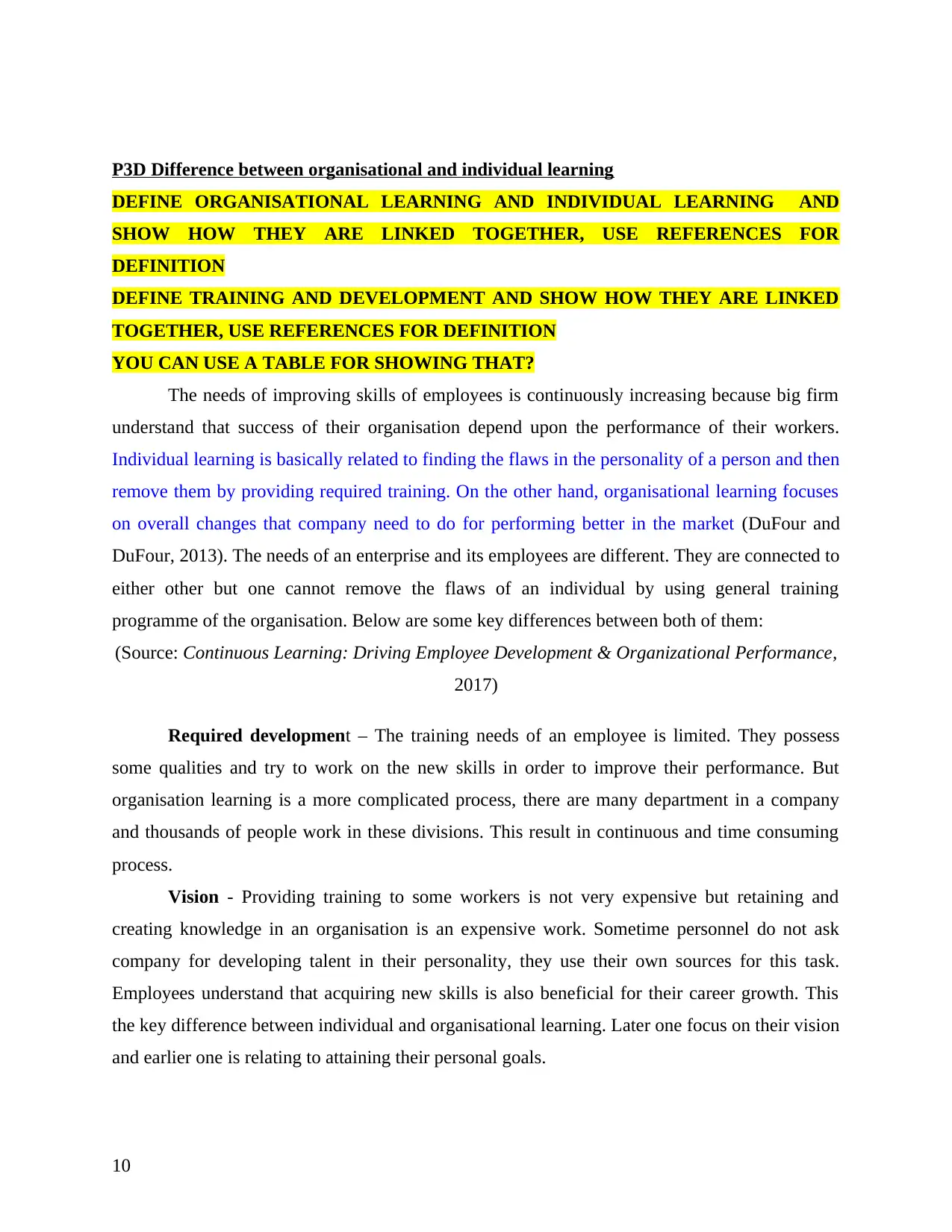
P3D Difference between organisational and individual learning
DEFINE ORGANISATIONAL LEARNING AND INDIVIDUAL LEARNING AND
SHOW HOW THEY ARE LINKED TOGETHER, USE REFERENCES FOR
DEFINITION
DEFINE TRAINING AND DEVELOPMENT AND SHOW HOW THEY ARE LINKED
TOGETHER, USE REFERENCES FOR DEFINITION
YOU CAN USE A TABLE FOR SHOWING THAT?
The needs of improving skills of employees is continuously increasing because big firm
understand that success of their organisation depend upon the performance of their workers.
Individual learning is basically related to finding the flaws in the personality of a person and then
remove them by providing required training. On the other hand, organisational learning focuses
on overall changes that company need to do for performing better in the market (DuFour and
DuFour, 2013). The needs of an enterprise and its employees are different. They are connected to
either other but one cannot remove the flaws of an individual by using general training
programme of the organisation. Below are some key differences between both of them:
(Source: Continuous Learning: Driving Employee Development & Organizational Performance,
2017)
Required development – The training needs of an employee is limited. They possess
some qualities and try to work on the new skills in order to improve their performance. But
organisation learning is a more complicated process, there are many department in a company
and thousands of people work in these divisions. This result in continuous and time consuming
process.
Vision - Providing training to some workers is not very expensive but retaining and
creating knowledge in an organisation is an expensive work. Sometime personnel do not ask
company for developing talent in their personality, they use their own sources for this task.
Employees understand that acquiring new skills is also beneficial for their career growth. This
the key difference between individual and organisational learning. Later one focus on their vision
and earlier one is relating to attaining their personal goals.
10
DEFINE ORGANISATIONAL LEARNING AND INDIVIDUAL LEARNING AND
SHOW HOW THEY ARE LINKED TOGETHER, USE REFERENCES FOR
DEFINITION
DEFINE TRAINING AND DEVELOPMENT AND SHOW HOW THEY ARE LINKED
TOGETHER, USE REFERENCES FOR DEFINITION
YOU CAN USE A TABLE FOR SHOWING THAT?
The needs of improving skills of employees is continuously increasing because big firm
understand that success of their organisation depend upon the performance of their workers.
Individual learning is basically related to finding the flaws in the personality of a person and then
remove them by providing required training. On the other hand, organisational learning focuses
on overall changes that company need to do for performing better in the market (DuFour and
DuFour, 2013). The needs of an enterprise and its employees are different. They are connected to
either other but one cannot remove the flaws of an individual by using general training
programme of the organisation. Below are some key differences between both of them:
(Source: Continuous Learning: Driving Employee Development & Organizational Performance,
2017)
Required development – The training needs of an employee is limited. They possess
some qualities and try to work on the new skills in order to improve their performance. But
organisation learning is a more complicated process, there are many department in a company
and thousands of people work in these divisions. This result in continuous and time consuming
process.
Vision - Providing training to some workers is not very expensive but retaining and
creating knowledge in an organisation is an expensive work. Sometime personnel do not ask
company for developing talent in their personality, they use their own sources for this task.
Employees understand that acquiring new skills is also beneficial for their career growth. This
the key difference between individual and organisational learning. Later one focus on their vision
and earlier one is relating to attaining their personal goals.
10
Paraphrase This Document
Need a fresh take? Get an instant paraphrase of this document with our AI Paraphraser

Methods of learning – Employees uses internet, attend seminars and conferences for
developing skills (Kolb, 2014). In their training programme, they for on acquiring some special
talent so they can perform new tasks in an effective way. Organisational learning is completely
different from the individual (Continuous Learning: Driving Employee Development &
Organizational Performance, 2017). Transferring knowledge and gaining experience are main
method which an enterprise use for achieving their targets.
P4E Requirement of continuous learning and professional development
DEFINE AND EXPLAIN CONTINUOUS LEARNING USE REFERENCES?
DEFINE AND EXPLAIN PROFESIONAL DEVELOPMENT USE REFERENCES?
An organisation try to find the mistakes which make negative impact on their growth,
they work on their flaws in order to attain their mission. Continuous learning is essential for both
company as well as its employees (Macdonald and Poniatowska, 2011). Staff members are key
resources that is present in an enterprise. Their ideas and efforts are main reason behind success
of a Big corporation.
Continuous learning is the practice of increasing the knowledge in an individual by putting daily
efforts (Macdonald and Poniatowska, 2011).
An organisation can solve one issue which is pulling them back from expanding but, in
this business environment, new troubles will arise on next day. Continuous learning can help an
organisation in effectively dealing with various challenges which they are facing in present
scenario. It may also help them in forthcoming time, if mentioned company will have necessary
skills that is required to cope up with forthcoming challenges then they face future challenges in
an effective manner. The strategies and methods of business which they were using before four
decades are now considered outdated. Continuous learning played significant role adopting the
new technologies and ideas (Van, Driel and Berry, 2012). It helped them for making necessary
adjustment in this rapidly changing business environment.
(Source: 15 Professional Development Skills, 2017)
Employees are essential resources of an organisation. Professional development is
necessary for making a quality workforce. Workers of an enterprise provide them some extra
over their competitors. Tesco can hold the top spot in their industry if they focus on continuous
learning of individual as well as organisation. One time success cannot make big organisation
11
developing skills (Kolb, 2014). In their training programme, they for on acquiring some special
talent so they can perform new tasks in an effective way. Organisational learning is completely
different from the individual (Continuous Learning: Driving Employee Development &
Organizational Performance, 2017). Transferring knowledge and gaining experience are main
method which an enterprise use for achieving their targets.
P4E Requirement of continuous learning and professional development
DEFINE AND EXPLAIN CONTINUOUS LEARNING USE REFERENCES?
DEFINE AND EXPLAIN PROFESIONAL DEVELOPMENT USE REFERENCES?
An organisation try to find the mistakes which make negative impact on their growth,
they work on their flaws in order to attain their mission. Continuous learning is essential for both
company as well as its employees (Macdonald and Poniatowska, 2011). Staff members are key
resources that is present in an enterprise. Their ideas and efforts are main reason behind success
of a Big corporation.
Continuous learning is the practice of increasing the knowledge in an individual by putting daily
efforts (Macdonald and Poniatowska, 2011).
An organisation can solve one issue which is pulling them back from expanding but, in
this business environment, new troubles will arise on next day. Continuous learning can help an
organisation in effectively dealing with various challenges which they are facing in present
scenario. It may also help them in forthcoming time, if mentioned company will have necessary
skills that is required to cope up with forthcoming challenges then they face future challenges in
an effective manner. The strategies and methods of business which they were using before four
decades are now considered outdated. Continuous learning played significant role adopting the
new technologies and ideas (Van, Driel and Berry, 2012). It helped them for making necessary
adjustment in this rapidly changing business environment.
(Source: 15 Professional Development Skills, 2017)
Employees are essential resources of an organisation. Professional development is
necessary for making a quality workforce. Workers of an enterprise provide them some extra
over their competitors. Tesco can hold the top spot in their industry if they focus on continuous
learning of individual as well as organisation. One time success cannot make big organisation
11

like Tesco, they have to set aggressive objectives and try to attain them by using available
resources. Continuous learning help in enhancing loyalty from the side of employee (15
Professional Development Skills, 2017). It increases productivity of workers which is benefit for
company and to an individual also. Happier employees is another advantage of professional
development, this result in higher retention rate. Companies who focus on learning can easily
earn required amount of profit (Darling-Hammond and McLaughlin, 2011). Professional
development in learning of various subjects which can help in earning and attaining career
growth (Darling-Hammond and McLaughlin, 2011).
Below are some sources for professional development in order to maintain sustainable
business performance:
Conferences and seminar – There are many events organised by various entities like
industry experts, media etc. mentioned company should send some of their talented workers in
these programme because it will help company is getting up to date knowledge about the things
that is happening in retail sector. This will enhance capability of workers and their learning can
be used in the organisation.
Coaching – Besides practical knowledge, it is important to teach theoretical concepts to
the staff members in order to make strong base (Buchem, Attwell and Torres, 2011). This is
essential for developing various kind of skills in their personality which they can use in attaining
short and middle term targets. Mentioned firm has many experienced workers, they can arrange a
coaching session where new employees can take class and learn necessary knowledge about a
topic.
SECTION 2
P5I Contribution of high performance working towards competitive advantage and
employee engagement
DEFINE HPW USE REFERENCES?
IDENTIFY THE FEATURES OF HPW?
DISCUSS CONDITION THAT LEAD TO HPW?
SUMMARISE THE OUTCOMES OF HPW IN ORGANISATION?
12
resources. Continuous learning help in enhancing loyalty from the side of employee (15
Professional Development Skills, 2017). It increases productivity of workers which is benefit for
company and to an individual also. Happier employees is another advantage of professional
development, this result in higher retention rate. Companies who focus on learning can easily
earn required amount of profit (Darling-Hammond and McLaughlin, 2011). Professional
development in learning of various subjects which can help in earning and attaining career
growth (Darling-Hammond and McLaughlin, 2011).
Below are some sources for professional development in order to maintain sustainable
business performance:
Conferences and seminar – There are many events organised by various entities like
industry experts, media etc. mentioned company should send some of their talented workers in
these programme because it will help company is getting up to date knowledge about the things
that is happening in retail sector. This will enhance capability of workers and their learning can
be used in the organisation.
Coaching – Besides practical knowledge, it is important to teach theoretical concepts to
the staff members in order to make strong base (Buchem, Attwell and Torres, 2011). This is
essential for developing various kind of skills in their personality which they can use in attaining
short and middle term targets. Mentioned firm has many experienced workers, they can arrange a
coaching session where new employees can take class and learn necessary knowledge about a
topic.
SECTION 2
P5I Contribution of high performance working towards competitive advantage and
employee engagement
DEFINE HPW USE REFERENCES?
IDENTIFY THE FEATURES OF HPW?
DISCUSS CONDITION THAT LEAD TO HPW?
SUMMARISE THE OUTCOMES OF HPW IN ORGANISATION?
12
⊘ This is a preview!⊘
Do you want full access?
Subscribe today to unlock all pages.

Trusted by 1+ million students worldwide
1 out of 18
Related Documents
Your All-in-One AI-Powered Toolkit for Academic Success.
+13062052269
info@desklib.com
Available 24*7 on WhatsApp / Email
![[object Object]](/_next/static/media/star-bottom.7253800d.svg)
Unlock your academic potential
Copyright © 2020–2025 A2Z Services. All Rights Reserved. Developed and managed by ZUCOL.





